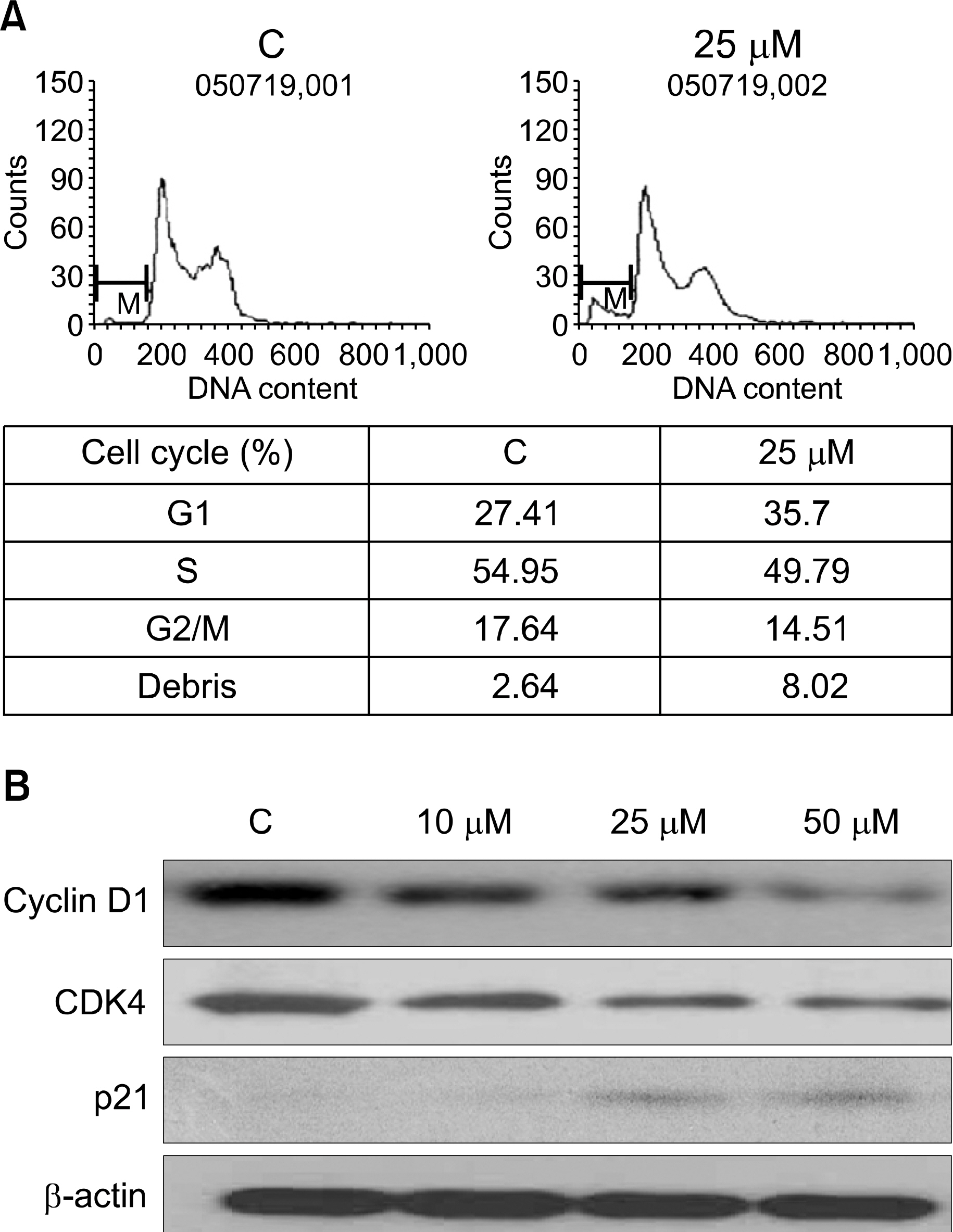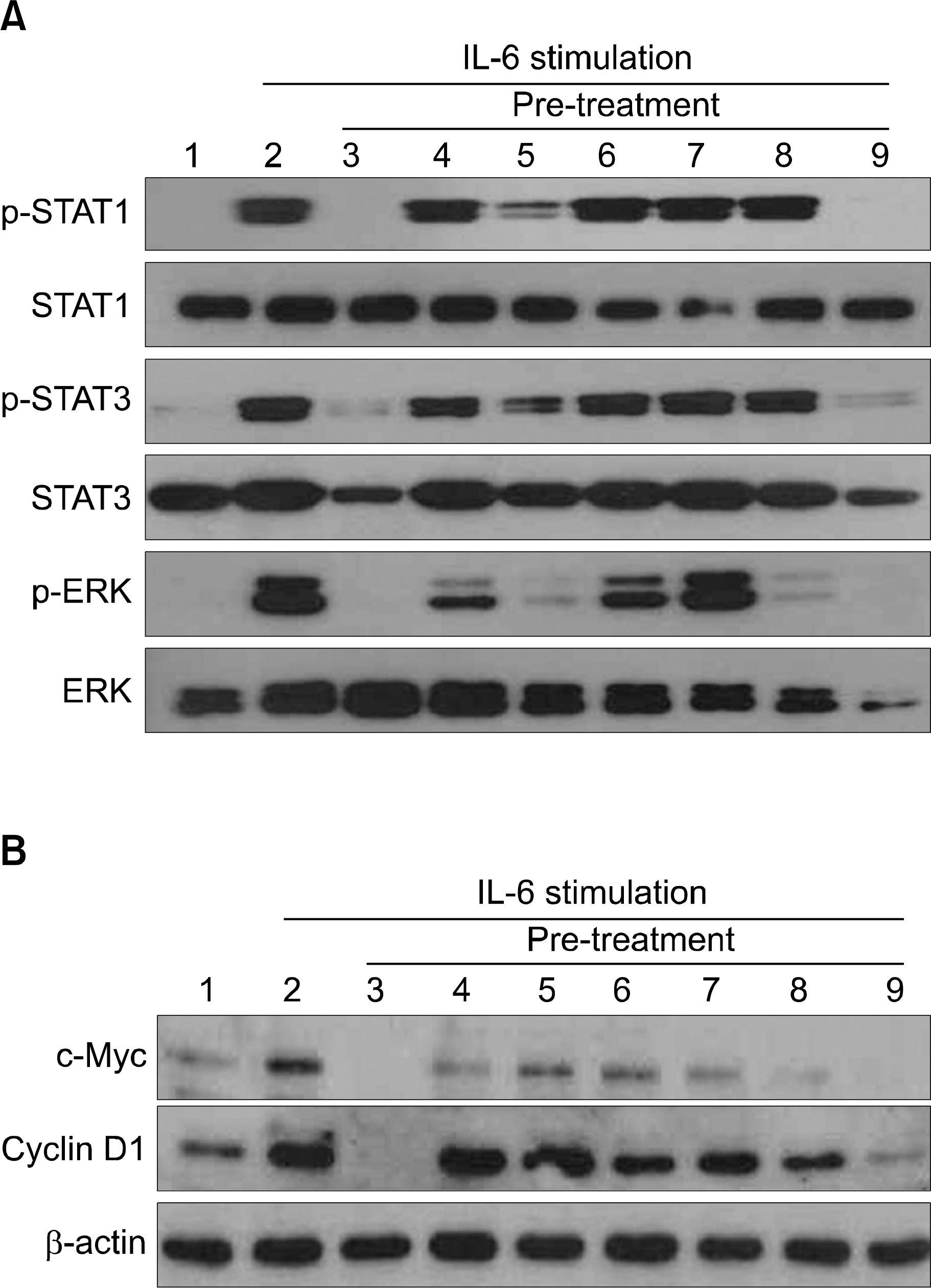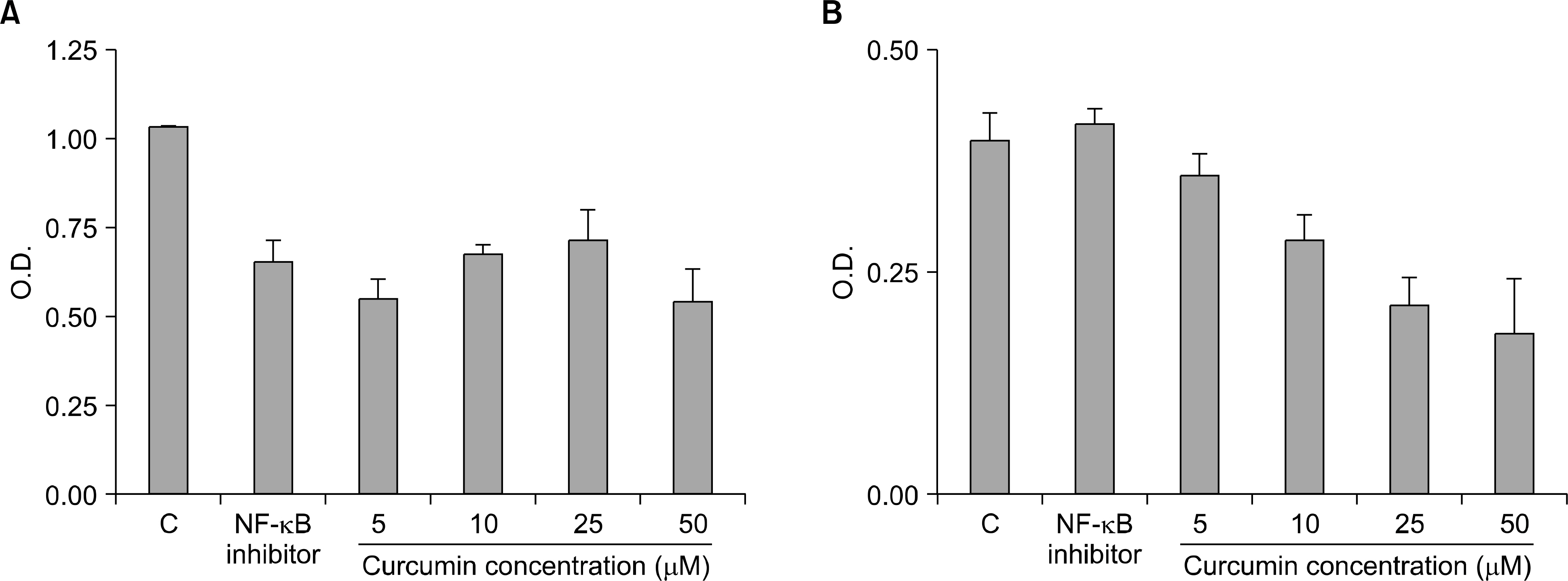Korean J Hematol.
2008 Mar;43(1):19-27. 10.5045/kjh.2008.43.1.19.
Abrogation of U266 Multiple Myeloma Cell Proliferation Via Inhibition of NF-kappaB Activation by Curcumin
- Affiliations
-
- 1Cancer Research Institute, Seoul National University College of Medicine, Seoul, Korea. ssysmc@snu.ac.kr
- 2Department of Internal Medicine, Seoul National University College of Medicine, Seoul, Korea.
- 3Clinical Research Institute, Seoul National University Hospital, Seoul, Korea.
- 4Section of Hematology/Oncology, Hanyang University Hospital, Seoul, Korea.
- 5Ottogi Research Center, Anyang, Korea.
- KMID: 1485153
- DOI: http://doi.org/10.5045/kjh.2008.43.1.19
Abstract
-
BACKGROUND: Curcumin is a naturally occurring biologically active compound, and it has been shown to possess potent anti-inflammatory, anti-tumor and anti-oxidative properties. It is known for its anti-proliferative and proapoptotic effects in several cancer cells. Curcumin's effects on the mechanisms of cell survival and the expression of various cytokines were investigated in U266 cells and the in vivo effects of curcumin were examined using an animal model.
METHODS
Cell proliferation assay and flow cytometry were used to examine cell proliferation, along with cell cycle analysis. The protein expressions were analyzed by Western blotting and the expressed levels of cytokines were analyzed by the ELISA method.
RESULTS
Curcumin inhibited U266 cell growth in a dose-dependent and time-dependent manner. Cell cycle analysis showed an increased sub-G1 phase, a down regulated cyclinD1 expression and an induced p21 expression. Apoptosis induced a down regulated procaspase 3 expression and it induced cleaved PARP. Curcumin inhibited the IL (interleukin)-6 induced cell signal pathway via decreasing the STAT1 an 3, Erk cyclinD1 and c-myc expressions. Also, administration of 25mg/kg curcumin to a U266 animal model inhibited cancer cell engraftment in the bone marrow and it decreased the IL-6, sIL-6R and IL-8 expression levels.
CONCLUSION
Curcumin induced cell cycle arrest and apoptosis and it inhibited the IL-6 mediated signal transduction pathways in U266 cells. Similar to the in vitro results, curcumin inhibited cancer cell proliferation and the expression of cytokine in vivo.
Keyword
MeSH Terms
-
Animals
Apoptosis
Blotting, Western
Bone Marrow
Caspase 3
Cell Cycle
Cell Cycle Checkpoints
Cell Proliferation
Cell Survival
Curcumin
Cytokines
Enzyme-Linked Immunosorbent Assay
Flow Cytometry
Interleukin-6
Interleukin-8
Models, Animal
Multiple Myeloma
NF-kappa B
Peptides
Signal Transduction
Caspase 3
Curcumin
Cytokines
Interleukin-6
Interleukin-8
NF-kappa B
Peptides
Figure
Reference
-
1). Hess U. The plasma cell myeloma—molecular pathogenesis and target therapies. Ther Umsch. 2006. 63:233–6.2). Oyeyinka GO., Ofei V., Maddy SQ, et al. Homogeneous immunoglobulins in Ghanaians living in Accra, Ghana. Afr J Med Med Sci. 2004. 33:311–6.3). Umeda M., Adachi Y., Tomiyama J, et al. Bone lesions in elderly multiple myeloma. Nippon Ronen Igakkai Zasshi. 2002. 39:631–8.
Article4). Shionoiri A., Horiuchi T., Onouchi T, et al. Hypercalcemia induced with the plasma levels of parathyroid hormone-related peptide in multiple myeloma. Intern Med. 2000. 39:810–3.
Article5). Tucci M., Grinello D., Cafforio P., Silvestris F., Dammacco F. Anemia in multiple myeloma: role of deregulated plasma cell apoptosis. Leuk Lymphoma. 2002. 43:1527–33.
Article6). Bharti AC., Shishodia S., Reuben JM, et al. Nuclear factor-kappaB and STAT3 are constitutively active in CD138+ cells derived from multiple myeloma patients, and suppression of these transcription factors leads to apoptosis. Blood. 2004. 103:3175–84.7). Anderson KC., Lust JA. Role of cytokines in multiple myeloma. Semin Hematol. 1999. 36(1 Suppl 3):14–20.8). Costes V., Portier M., Lu ZY., Rossi JF., Bataille R., Klein B. Interleukin-1 in multiple myeloma: producer cells and their role in the control of IL-6 production. Br J Haematol. 1998. 103:1152–60.
Article9). Lee JW., Chung HY., Ehrlich LA, et al. IL-3 expression by myeloma cells increases both osteoclast formation and growth of myeloma cells. Blood. 2004. 103:2308–15.
Article10). Treon SP., Anderson KC. Interleukin-6 in multiple myeloma and related plasma cell dyscrasias. Curr Opin Hematol. 1998. 5:42–8.
Article11). Jourdan M., Tarte K., Legouffe E., Brochier J., Rossi JF., Klein B. Tumor necrosis factor is a survival and proliferation factor for human myeloma cells. Eur Cytokine Netw. 1999. 10:65–70.12). Qiang YW., Kopantzev E., Rudikoff S. Insulinlike growth factor-I signaling in multiple myeloma: downstream elements, functional correlates, and pathway cross-talk. Blood. 2002. 99:4138–46.
Article13). Nishino H., Tokuda H., Satomi Y, et al. Cancer prevention by antioxidants. Biofactors. 2004. 22:57–61.
Article14). Liao S., Lin J., Dang MT, et al. Growth suppression of hamster flank organs by topical application of catechins, alizarin, curcumin, and myristoleic acid. Arch Dermatol Res. 2001. 293:200–5.
Article15). Ammon HP., Wahl MA. Pharmacology of Curcuma longa. Planta Med. 1991. 57:1–7.16). Koo JY., Kim HJ., Jung KO., Park KY. Curcumin inhibits the growth of AGS human gastric carcinoma cells in vitro and shows synergism with 5-fluorouracil. J Med Food. 2004. 7:117–21.17). Sun M., Yang Y., Li H, et al. The effect of curcumin on bladder cancer cell line EJ in vitro. Zhong Yao Cai. 2004. 27:848–50.18). Li H., Che Y., Tang W. Effects of curcumin on proliferation and apoptosis in human hepatic cells. Zhonghua Gan Zang Bing Za Zhi. 2002. 10:449–51.19). Kuo ML., Huang TS., Lin JK. Curcumin, an antioxidant and anti-tumor promoter, induces apoptosis in human leukemia cells. Biochim Biophys Acta. 1996. 1317:95–100.
Article20). Duvoix A., Morceau F., Schnekenburger M, et al. Curcumin-induced cell death in two leukemia cell lines: K562 and Jurkat. Ann N Y Acad Sci. 2003. 1010:389–92.
Article21). Puthier D., Bataille R., Amiot M. IL-6 up-regulates mcl-1 in human myeloma cells through JAK/STAT rather than ras/MAP kinase pathway. Eur J Immunol. 1999. 29:3945–50.
Article22). Tobe M., Isobe Y., Tomizawa H., Nagasaki T., Takahashi H., Hayashi H. A novel structural class of potent inhibitors of NF-kappa B activation: structure-activity relationships and biological effects of 6-aminoquinazoline derivatives. Bioorg Med Chem. 2003. 11:3869–78.23). Mitsiades N., Mitsiades CS., Richardson PG, et al. The proteasome inhibitor PS-341 potentiates sensitivity of multiple myeloma cells to conventional chemotherapeutic agents: therapeutic applications. Blood. 2003. 101:2377–80.
Article24). Schenkein D. Proteasome inhibitors in the treatment of B-cell malignancies. Clin Lymphoma. 2002. 3:49–55.
Article25). Salem M., Elbaz O., Zahran M, et al. Malignancy: identification of predictors of disease status and progression in patients with myeloma (MM). Hematology. 2000. 5:41–5.
- Full Text Links
- Actions
-
Cited
- CITED
-
- Close
- Share
- Similar articles
-
- NF-kappaB Activation in T Helper 17 Cell Differentiation
- The CXCR4 Antagonist AMD3100 Has Dual Effects on Survival and Proliferation of Myeloma Cells In Vitro
- The Role of NF-kappaB in the TNF-alpha-induced Apoptosis of Lung Cancer Cell Line
- Role of protein kinases on NF- kappaB activation and cell death in bovine cerebral endothelial cells
- Curcumin Enhances Docetaxel-Induced Apoptosis of 8505C Anaplastic Thyroid Carcinoma Cells







